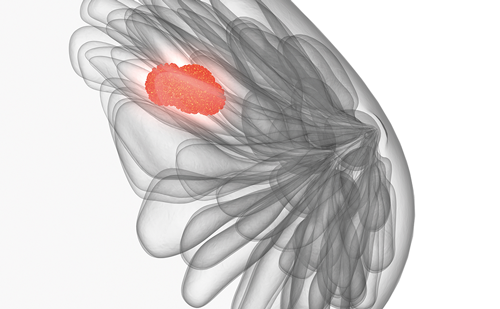Breast cancer and its treatment may have a negative effect on bone health. Some cancer therapies may lead to accelerated bone loss. Since breast cancer is a common condition that is often cured, the effects on bone health are a major concern for survivors as it can put them at risk of fractures that can significantly impact their quality of life.
Q. What is the impact of breast cancer and its treatment on bone health?
There is a very strong link between breast cancer and treatment for breast cancer, and skeletal deterioration and fracture risk. First of all, women with breast cancer are usually post-menopausal and thus have low bone mineral density (BMD) at baseline even prior to starting treatment. Furthermore, the great majority of women who start treatment for breast cancer often undergo an abrupt transition to a hormonal milieu that is associated with accelerated bone loss and increased risk of fractures for the duration of treatment as well as in their lifetime. The latter is true for both pre- and postmenopausal women. In the Women’s Health Initiative study, breast cancer survivors had a 15% increased risk of fractures compared with cancer-free women.1Therapies used in the treatment of breast cancer that can accelerate bone loss include chemotherapy, hormone ablation therapy resulting in hypogonadism, antiestrogen therapies, radiation, and concurrent medications such as glucocorticoids. They render patients at risk for osteoporosis and fragility fractures that can compromise their quality of life and longevity.
Chemotherapy for breast cancer has been associated with lower BMD in postmenopausal2 and premenopausal women.3–5 In premenopausal women chemotherapy is often associated with ovarian dysfunction due to direct toxicity and interference with follicle maturation, meaning menopause can occur about 10 years earlier than it would naturally.3 40% to 95% of women who receive chemotherapy experience premature ovarian insufficiency, depending on the regimen and their age.4,5
Premature menopause due to ovarian suppression with gonadotropin-releasing hormone (GnRH) agonists, oophorectomy, or cytotoxic chemotherapy decreases circulating estrogen which accelerates bone resorption and decreases BMD. GnRH agonists act on gonadotropin receptors of the pituitary gland, reducing estrogen production. BMD decline is in the range of 3–7% in women on chemotherapy,6 5% on GnRH agonists,7 and as high as 18–19% over 2 years after oophorectomy.8 Short-term fractures are overall low in this younger, premenopausal population. However, these young women are treated with curative intent and expected to have decades of life expectancy after completing breast cancer therapy, hence this early significant bone loss is disadvantageous later in life.
Antiestrogen therapy with tamoxifen and aromatase inhibitors has been the mainstay of treatment in hormone receptor-positive breast cancer. Tamoxifen, a selective estrogen receptor modulator, has both agonist and antagonist effects on the estrogen receptor. It is an estrogen antagonist in the breast regardless of pre- or postmenopausal status, but also an estrogen agonist within the bone. In postmenopausal women tamoxifen protects against bone loss,9,10 with a 32% relative risk reduction in fractures compared with placebo.10 In contrast, tamoxifen decreases BMD in premenopausal women, even if they maintain regular menstrual cycles.9
Aromatase inhibitors such as letrozole, anastrozole, and exemestane block the conversion of androgen to estrogen, primarily in adipose tissue, by inhibiting the aromatase enzyme, thus profoundly decreasing serum estrogen levels in postmenopausal women. In premenopausal women an aromatase inhibitor may only be used with surgical or chemical ovarian ablation, as aromatase inhibitors do not affect ovarian estrogen production. In postmenopausal women adjuvant aromatase inhibitors are superior to tamoxifen and widely used. In those women, aromatase inhibitors accelerate bone loss and increase fracture risk by at least around 10%11–14 and up to double that (by 18–20%) after 5 years of treatment.15 Longer duration of aromatase inhibitor therapy is associated with higher increases in the risk of fracture, at 14% versus 9% in those treated for 10 years versus 5 years respectively.16
Local radiation therapy interrupts the vascular supply in the bone, and directly contributes to hypoxia, which inhibits osteoblast function and increases osteoclastogenesis.17 Radiation-related bone-specific toxicities include bone loss within the field of radiation, osteopenia or osteoporosis, increased risk of fracture, and avascular necrosis.18
Q. What can be done to maintain bone health in patients with breast cancer who are receiving endocrine therapy?
All women receiving treatment for breast cancer should be evaluated for their risk of fracture at the onset of therapy, particularly because osteoporosis may be a preexisting condition. Several bone and oncologic societies have published specific guidelines.15,19 A thorough history and ideally a dual-energy X-ray absorptiometry (DXA) scan should be performed. Emphasis should be given to a healthy diet and normal weight. Adequate intake of dietary protein and natural antioxidants found in fruit and vegetables, rather than in supplements, is encouraged. We recommend avoiding excessive carbohydrates given recent indications that women with breast cancer on hormonal therapies may be at higher risk for developing diabetes, which in itself is a significant risk factor for fractures. In addition, habits detrimental to the bones such as smoking, excess caffeine, colored carbonated beverages, and alcohol, should be avoided.
The foundation of maintaining bone health includes intake of adequate calcium (1,000–1,200 mg daily, preferably from food sources; however, supplements may be added) and vitamin D ~800–1,000 units/d for a 25-OH vitamin D level above 30 ng/mL, as is recommended for fall and fracture prevention in the general osteoporosis population.20 Adequate calcium and vitamin D intake is important in decreasing the risk of hypocalcemia and maintaining bone mineralization in the setting of antiresorptive therapies.
Adequate weight-bearing and resistance exercise is also important and has been shown to limit bone loss in postmenopausal women with breast cancer,21 although fracture risk reduction has not been demonstrated.15
Lastly, medications that reduce bone resorption such as bisphosphonates and denosumab are widely used and indicated in these women as the only effective means to actually reduce fracture risk. In postmenopausal women with breast cancer receiving aromatase-inhibitor therapy, oral bisphosphonates (alendronate, ibandronate, and risedronate) when used up to 5 years are associated with increases in BMD and reduction in fracture risk.15
The AZURE (Adjuvant Zoledronic Acid to Reduce Recurrence) trial investigated the addition of zoledronic acid to standard adjuvant treatments in patients with early breast cancer, over a treatment period of 5 years. The results showed that the addition of zoledronic acid significantly lowered overall fracture rate by 6.2% versus 8.3% in the control group.22 In the Z-FAST (Zometa-Femara Adjuvant Synergy Trial) and ZO-FAST (Zometa-Femara Adjuvant Synergy Trial) studies, postmenopausal women on adjuvant aromatase-inhibitor therapy were randomized to either upfront use of zoledronic acid (4 mg every 6 months) or delayed use of the ZOL regimen.14,23 Both studies found that those treated with zoledronic acid up-front had increases in BMD, but fracture rates were not statistically different across the treatment arms.
Denosumab, 60 mg every 6 months, is approved for women on aromatase inhibitors at high risk for osteoporotic fracture. The ABCSG-18 (Austrian
Breast Cancer Study Group) trial of denosumab versus placebo24 demonstrated that time to first clinical fracture was decreased in the denosumab-treated group regardless of baseline BMD or age.24 As expected, denosumab was associated with increasing BMD at all skeletal sites.
Q. What factors should be considered when including a bone-targeted agent in breast cancer therapy of postmenopausal women?
The most important factors are the baseline BMD measurement along with the presence of certain co-morbidities that may affect adherence to treatment or increase the risk of adverse events. In a joint position statement from several societies, medical treatment is recommended in patients with a T-score less than −2.0 or if two or more clinical risk factors are present, including age >65 years old, low body mass index (<20), smoking (current or history), personal history of fracture after 50 years of age, family history of hip fracture, glucocorticoid use of >6 months, and T-score less than −1.5.15,19 When T-scores are greater than −2.0 with no other risk factors, then monitoring for bone loss every 1–2 years is a reasonable option.15 Some experts support treatment of premenopausal women with antiresorptive therapy if they have undergone ovarian suppression and are receiving an aromatase inhibitor, with a T-score less than −1.0, or with a prevalent vertebral fracture, although data are limited.25
Certain co-morbidities exclude certain therapies, for example kidney disease (bisphosphonates) and severe gastroesophageal reflux disease or dysphagia (oral bisphosphonates). Adherence to oral medications is a challenging issue in the treatment of osteoporosis in general. The anabolic agents teriparatide and abaloparatide, and agents containing estrogen, should be avoided in patients with breast cancer due to the concern for stimulating the growth of micrometastatic occult tumor cells and increasing the risk of breast cancer recurrence, as well as the potential increased risk of osteosarcoma in areas exposed to skeletal radiation. We do not have any data available regarding the efficacy and safety of a recently approved anti-sclerostin antibody with combined anabolic and antiresorptive effect (romosozumab) in women with breast cancer.
Q. What data support the effectiveness of bisphosphonates and denosumab in reducing the risk of bone recurrences and breast cancer deaths in postmenopausal women?
A meta-analysis by the Early Breast Cancer Trialists’ Collaborative Group used individual patient data from all trials in early breast cancer that randomized patients to either bisphosphonates or control, and analyzed for cancer outcomes.26 In postmenopausal women (n=11,767), treatment with a bisphosphonate was associated with a significant decrease in risk of breast cancer recurrence, distant recurrence, bone recurrence, and breast cancer mortality. Thus, experts generally recommend use of adjuvant bisphosphonates in postmenopausal women who are at high risk for breast cancer recurrence,27 although we are not yet certain of the exact mechanism of this phenomenon.
Adjuvant denosumab is being studied for potential anticancer effects. Preliminary results of the ABCSG-18 study reported in 2015 at the San Antonio Breast Cancer Symposium noted that the addition of denosumab to adjuvant aromatase inhibitors reduced the risk of breast cancer recurrence by ~18%.28 However the DCARE (Study of Denosumab as Adjuvant Treatment of Women With High Risk Early Breast Cancer Receiving Neoadjuvant or Adjuvant Therapy) study, which randomized women with breast cancer to adjuvant denosumab (120 mg every 6 months) or to placebo did not show an effect in disease-free survival and overall survival.29
Q. What are the other advantages and risks of including bone-targeted therapies in breast cancer therapy?
Bone targeted therapies are very effective in reducing fracture risk while also being very well tolerated with minimal, and generally reversible, adverse events.30–41 Therefore, their benefit to risk ratio is highly favorable despite the negative publicity that they have received in the lay press, regarding extremely rare adverse events such as osteonecrosis of the jaw or atypical femoral fractures.42 Antiresorptives have been associated with osteonecrosis of the jaw, thus is exposed jaw bone with delayed healing in 1/300,000 patients and usually associated with another risk factor such as poor dental and oral hygiene, use of dentures, Vitamin D deficiency, use of steroids and invasive dental procedure such as extractions and implant post insertion.43 Thus, good oral hygiene and routine dental care is encouraged for patients receiving this therapy.43 Another extremely rare adverse event associated with long-term treatment with antiresorptives is atypical subtrochanteric femoral fractures, which may limit the duration of treatment of bisphosphonates due to their accumulation in the skeleton, necessitating a drug holiday. Patients should be monitored for prodromal symptoms that usually precede those fractures.44
A recent concern is the rise in fracture risk upon discontinuation of denosumab.45 There are ongoing clinical trials assessing the protective effect of using a bisphosphonate subsequent to denosumab and this is often common practice nowadays in our patients.46-50 Overall, however, the benefits of antiresorptive agents in women with breast cancer, as well as the general population of women with osteoporosis, greatly outweigh the risks.











